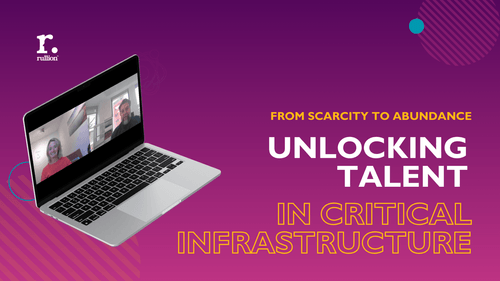From Scarcity to Abundance: Unlocking Talent in Critical Infrastructure
John Shepherd, Client Services Director at Rullion, recently sat down with Lindsay Harrison, Rullion’s Chief Customer Officer and Chair for Engineering Recruitment at APSCo UK, to examine why the skills shortage story in energy industry recruitment agencies and engineering needs to change.
Their conversation explored how an abundance mindset, grounded in inclusion, transferable skills and smarter workforce strategies, can help critical infrastructure employers unlock hidden talent pools and build the capability needed for the decade ahead.
Energy consumption overall is declining while electricity demand is surging. Electric vehicles, heat pumps, AI and data centres are driving a projected 50% rise in demand by 2035. The shift is powered by Net Zero goals, energy security and rapid technology adoption. The pull is so strong that firms like Microsoft and Google are investing directly in the Energy sector.
“This isn’t something coming down the road,” John explains. “We’re in it right now.”
The energy transition could create nearly three quarters of a million green jobs in the UK by 2030. The Nuclear Industry Association’s jobs map shows civil nuclear roles rising from 64,000 to 87,000 in three years. The Financial Times reports green jobs up 36% since 2015.
These are not abstract statistics. They reflect projects Rullion supports, from Hinkley Point C to Sizewell C. If those roles are being filled, talent exists. The challenge is access.
The Challenge with the Scarcity Narrative
Negative headlines dominate LinkedIn, trade journals, and national news. “Skills shortage” grabs attention, stirs emotion, and generates clicks. But, as John points out:
“News is designed to be bad and negative. It grabs attention. It stirs up emotion. It’s clickbait. That scarcity narrative is stifling opportunity.”
The reality is that the UK energy recruitment market is growing. The bigger challenge isn’t the absence of talent; it’s the barriers we’ve created that stop it flowing into the right roles.
Lindsay adds a customer lens. Clients tell her they cannot find people, yet the real issue is how talent is defined, where it is sought and how candidates experience the journey. Reframing those inputs unlocks supply.
Challenge 1: Rigid Job Specifications
Overly prescriptive job specs, especially those demanding exact, like-for-like industry experience, instantly narrow the search and shut out skilled candidates. In critical infrastructure, where delivery deadlines are tight and skill demands shift quickly, this rigidity can slow projects and drive-up costs.
Some qualifications are non-negotiable, but industry-specific experience isn’t always essential. As John points out:
“Great engineers from aerospace, defence, and construction can bring huge value. They’re problem solvers, safety-minded, and used to working in complex, regulated environments.”
These sectors operate under stringent compliance requirements, manage high-risk projects, and demand the same precision and safety culture as energy sector roles. Overlooking these candidates because they haven’t “done it here before” means missing out on proven capability.
Challenge 2: Candidate Experience Barriers
The process shapes outcomes. If interviews lack inclusion, feedback is unclear or applications are hard to complete, strong candidates step away before shortlist. The effect is even sharper for underrepresented groups.
This is a priority area for Lindsay.
“Every interaction matters,” she says. “From the language in a job description to who is on the panel, the experience tells candidates whether they belong. If it does not feel inclusive, great people disengage before they can show what they can do.”
Treating candidates as customers improves conversion and strengthens reputation across Energy recruitment communities.
Challenge 3: Overlooked Talent Pools
Veterans. Neurodiverse professionals. Returning parents. Mid-career switchers. These people bring the mindset and capabilities to excel in critical infrastructure, yet traditional screening often filters them out.
“They’re all here,” John says. “They’re all skilled. They’re all ready. But in many cases, they’re being overlooked because of outdated systems, processes, and mindsets.”
CV gaps, career changes and non-linear paths are interpreted as risk instead of potential. Lindsay argues for evidence over assumptions and points to lived examples.
Challenge 4: Shared Responsibility
The responsibility for change doesn’t sit solely with recruiters. Hiring managers, in-house talent teams, and recruitment partners all play a role in broadening searches and challenging old habits.
As Lindsay puts it:
“It’s not one-sided. We all need to look wider than we have in the past.”
This means collaboration at every stage. From shaping job specs and identifying transferable skills, to designing inclusive selection processes that open the gates rather than narrowing them.
Four Solutions for an Abundant Workforce
1. Change the Mindset
Scarcity talk grows the problem. John’s advice is simple: ask better questions. Where else can we look, what is truly essential, what can be trained and how do we widen the gate without compromising safety or quality?
“If we keep saying we can’t find talent, the problem will only get bigger,” John warns.
2. Open the Gates with Inclusive Hiring
By rethinking job specs, reducing unnecessary barriers, and designing inclusive selection processes, employers can attract a wider range of applicants, and benefit from the innovation and resilience that come with diversity. Lindsay champions consistent feedback loops so candidates feel respected even when the answer is no. That reputation compounds over time.
3. Build Talent, Don’t Just Buy It
Rullion’s Train to Deploy model converts abundance into delivery. Identify high-potential people on behaviours and learning agility, upskill them with project-specific training and deploy them into roles that add value from day one.
As part of our broader Train to Deploy Strategy, this helps Energy sector employers build internal capability instead of competing for a shrinking external pool. The result is faster readiness, better retention and teams formed around real work rather than perfect CVs.
4. Tell the Positive Stories
Stories shift markets. Case studies of hires from non-traditional backgrounds show what good looks like and attract more of it.
“The more we talk positively, the more people will listen,” John says. “The more people who listen will be drawn to this sector, and then you gain momentum.”
Lindsay’s view is practical: publish the wins, spotlight the teams and make success visible so others follow. See Rosie’s story from rail contracting, where flexibility and neurodiversity became advantages rather than obstacles: Rosie on rail contracting, flexibility and neurodiversity
A Call to the Sector
The UK’s energy and wider growth in critical infrastructure create one of the largest workforce shifts in decades. Leaders who move from scarcity to abundance will stop competing for the same small pool and start creating a broader, sustainable pipeline.
Lindsay sums it up: “If we want a workforce that can deliver the future, we must open the gate to people with potential, not only those who tick every box.”
John’s line completes the thought that talent isn’t scarce. Opportunity is gate.
“Our job is to open the gates.”
Watch the full interview here: https://youtu.be/8bwXFDm2-NE











